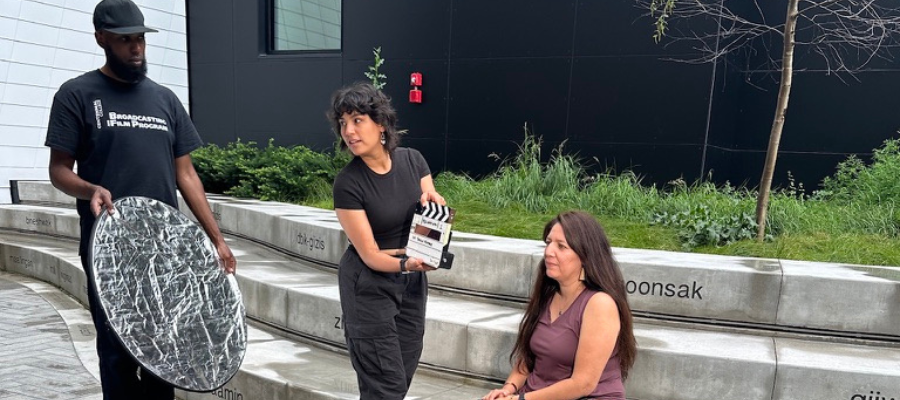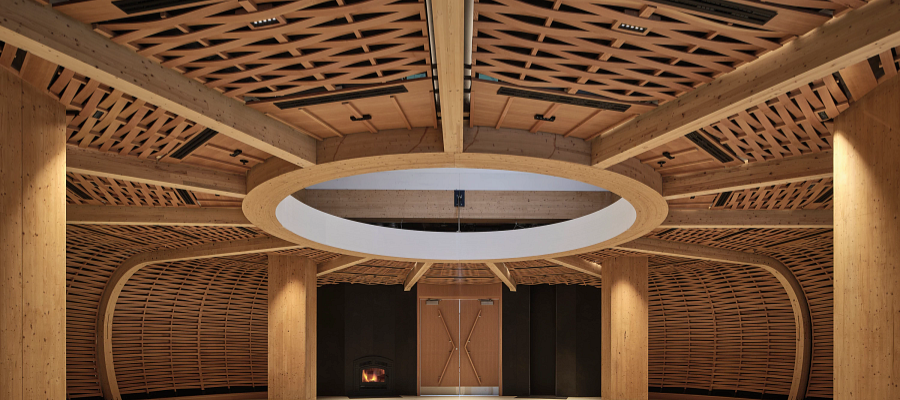When Indigenous children face a cancer diagnosis, access to care that acknowledges and respects their cultural traditions is important. With this in mind, the Pediatric Oncology Group of Ontario (POGO) partnered with Centennial College’s School of Communications, Media, Arts and Design to create a powerful video that features a blend of traditional Indigenous values and traditions and Western medicine. With the support of Centennial instructors and graduates, this video provides Indigenous families with accessible, culturally informed resources and insights during a critical time.
The Objective
“The video was conceived as a way to bridge the divide between First Nation parents and the childhood cancer establishment,” shares, Dr. Mark Greenberg, POGO Co-Founder and Co-Chair of the Indigenous Children with Cancer Committee.
Dr. Greenberg and his team worked with Centennial on the video from its inception, with an understanding that many experiences in adult Indigenous community involve advanced stages of cancer, which typically has poorer outcomes than childhood cancer, which has an 85% survival rate.
He explains, “We became aware that parents, in particular mothers, when asked for consent for treatment, typically invoked the advice of the elders, whose experience with cancer was the same. We needed to get a message across that childhood cancer is dramatically different from adult cancer, and we wanted to get that message across in a format that would have the language, rituals, the customs, and the imagery that might appeal to First Nations folks.”
While there are existing resources for Indigenous families, Dr. Greenberg notes that they can often generalize everyone and make assumptions of understanding. Instead, this video resource acknowledges the fact that First Nation folks can legitimately feel like Western medical establishments are antagonistic and provides an honest overview of childhood cancer. It also recognizes the unique challenges that Indigenous families may face on this difficult journey. “We all struggle with reconciliation,” Dr. Greenberg says. “This is a contribution to reconciliation from POGO and from Centennial.”
A Focus on the Disclosure Interview
The video focuses on the disclosure interview, which is where a healthcare professional lays out the details to a family, including the diagnosis, treatment, and prognosis. “The reason we picked that particular part of the journey is that there is a huge amount of information transmitted in those disclosure interviews at a time when parents are really shook up, in particular First Nations parents, who have been compelled, in a way, to interact with a Western medical system,” Dr. Greenberg explains.
He adds that the disclosure interview really turns a family’s life upside down, so the ability to frame things accurately, realistically, and gently is incredibly important. “That’s true for anyone with who you are sharing a disclosure interview, but for the First Nations people in particular, you want to be able to acknowledge but counteract perceptions of conflict between Western medicine and traditional Indigenous healing practices and spiritual practices.”
Because the video is organized into sections, Dr. Greenberg says it will allow First Nation folks who have just undergone a disclosure interview to be able to go back and review it as much as they want in sections to visually and auditorily grasp some of the ideas like what cancer is, why children get cancer, how to treat cancer, and more. Additionally, with Wendy Lariviere, a POGO Parent Ambassador and Childhood Cancer Advocate, guiding the interview with Dr. Greenberg and sharing her personal experience, the video provides a relatable presence that helps make the information more approachable and accessible.

Bringing the Video Together
The concept for this video originated at another educational institution before finding its home at Centennial. Glenn Lowry, Associate Vice-President of Applied Research, HyFlex Learning and Academic Partnership, introduced the project to Centennial, collaborating with Nate Horowitz, Dean of the School of Communications, Media, Arts and Design, and Jonathan Hack, Dean of Applied Research, Innovation, and Entrepreneurship.
Together, they served as executive producers and worked with the POGO and Centennial teams, including faculty and alums, to completely reimagine the project and any previous work on it to ensure it honoured Indigenous traditions while providing vital information for families.
Karen Shopsowitz, an instructor at Centennial, was the producer and oversaw the logistics. Alongside the creative team, she worked closely with Pamela Matthews, also an instructor at Centennial, who was the video's director. “Getting to know Pam also made this a great experience; we’d likely passed each other in the halls of the Story Arts Centre, never having met before,” Karen shares.
Nate brought Karen and Pamela together to collaborate on the video, acknowledging their dedication to the project. He also emphasizes Dr. Greenberg's valuable contributions to the video and the support, input, and corrections from Indigenous communities, recognizing how important it was to listen to these communities along the way as the video was slowly being put together. Reflecting on the final product, Nate underlines how the video showcases Indigenous culture, knowledge, and life, which are all significant elements of Centennial.
“When I first heard of the project through Nate, I really wanted to help make it happen,” Jonathan says. “Cancer care for children offers a high ‘cure’ rate – especially when acted upon quickly — but there is a reluctance by Indigenous communities to engage at such a pace due to their past experiences with colonialist approaches on other matters. Put simply, this project was very important, and if done properly, could make a deeply positive impact.”
As part of the project’s team, Jonathan met with Dr. Greenberg to discuss the vision and message. “To me, this resonated as a project that was fully aligned with how Centennial College seeks to engage on Indigenous matters – and a great opportunity for many of those on my research team to learn from the different perspectives the project would engage with,” he shares.
Now reflecting on the completed video, he says, “In the end, we were able to really embrace an approach that communicated the need for action while respecting Indigenous perspectives. It was authentic, impactful, and collaborative.”
Producing the Video
“When we had our first meeting with the POGO team, I was overwhelmed by the need for the project and how important it would be to the community,” Karen explains. She says that Dr. Greenberg told the team at the very first meeting that “this will literally save lives,” which stuck with Karen. “His and the rest of the team’s passion for the project meant that after that first meeting, we were committed to seeing it through to completion,” she adds.
Many students and graduates of Centennial’s Broadcasting program joined this project, taking on key positions. The video also included other faculty members, including Jason Milligan, who worked on sound, and John Lee, who worked on the opening and closing animation.
“The project brought us all together,” Karen says. “Our Director of Photography, Sean Sweeney, graduated a few years ago and worked closely with Laura Agudelo Montoya, who was our camera person, and Suleman Ibrahim, our grip/gaffer and lighting assistant. Our Production Manager was Maria Rodrigues de la Garza, who put her amazing on-set skills to great use. And, of course, Mark Tuscano, a recent graduate, did the edit. Also, Vince Talisayon was our graphics person. I think the entire group loved being a part of the process and knowing that they were part of something so important.”

Filming at Centennial’s New Indigenous Gathering Space
The majority of the video is filmed in an Indigenous space at Centennial, affectionately known as the Kookum’s Basket Room. Seán Kinsella, Director of The Eighth Fire at Centennial, who is featured in the video, explains, “The Kookum’s Basket Room is a place of ceremony and healing on the Centennial campus, and the walls feel like they are wrapping you in the love of a grandparent. That is the feeling we wanted those watching the video to feel as they navigate these difficult circumstances.”
This collaboration between POGO and Centennial showcases the power of storytelling. By blending traditional Indigenous practices and Western medicine, this video provides families with accessible, culturally respectful information during a challenging time. It stands as a testament to the importance of honouring Indigenous knowledge and the meaningful impact of community-driven projects.
Watch Childhood Cancer: A Guide for First Nations Communities.
--
Check out and subscribe to our Storyteller Newsletter and Storyteller In-Depth Podcast for more stories from the School of Communications, Media, Arts and Design.
